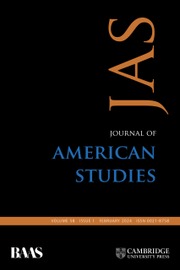Article contents
Hawthorne and Goldsmith: a Note
Published online by Cambridge University Press: 16 January 2009
Extract
Remarkably enough, Austin Warren calls Hawthorne ‘the unallusive Hawthorne’, but a mere four pages later he deduces from ‘The Hall of Fantasy’ in Mosses from an Old Manse that Homer, Aesop, Dante, Ariosto, Rabelais, Cervantes, Shakespeare, Spenser, Milton, and Bunyan were ‘Hawthorne's pantheon of the greatest creators’ and that Fielding, Richardson, Scott, and even poor Charles Brockden Brown were among his favourite novelists. As a matter of fact, to today's casual reader Hawthorne's work appears rather generously sprinkled with allusions to other writers and works. In spite of George Augustus Sala's remark: ‘Nobody ever saw him read…A friend who knew him well told me that on his shelves Hawthorne had not twenty volumes, and that these were of the most ordinary sort’, Warren and others have established without doubt that Hawthorne was a voracious reader all his life. When he was a young man it was said of him, ‘He's read every book in the [Salem] Athenaeum’. Furthermore, when Hawthorne did quote an author or refer to him, he did so from actual knowledge of that author's works. The majority of his quotations and allusions Hawthorne carefully labelled as quotations and allusions; but, occasionally, either consciously or unconsciously, he quoted—or perhaps echoed—without attribution. To point out such a ‘quotation’ is the purpose of this paper.
- Type
- Research Article
- Information
- Copyright
- Copyright © Cambridge University Press 1970
References
page 103 note 1 Warren, Austin, ‘Hawthorne's Reading’, New England Quarterly, VIII (12 1935), 482, 488.Google Scholar
page 103 note 2 Ibid. p. 480.
page 103 note 3 The remark is quoted by Warren, p. 486, and in Kesselring's, Marion L.Hawthorne's Reading, 1828–1850: A Transcription and Identification of Titles Recorded in the Charge-Books of the Salem Athenaeum (New York: New York, Public Library, 1949), p. 6Google Scholar. The Kesselring work is an amplification of the list of books withdrawn by Hawthorne which appeared earlier in ‘Books Read by Nathaniel Hawthorne, 1828–1850, From the “Charge Books” of the Salem Athenaeum’, Essex Institute Historical Collections, LXVIII (1932).Google Scholar
page 103 note 4 Warren quotes Randall Stewart as saying: ‘Hawthorne, we may be sure, made no pretension to knowledge which he did not actually possess.’ Warren adds: ‘If he characterized writers, however briefly, he had read them; or sampled them’, op. cit. p. 488 n. 30.
page 104 note 1 Essex Institute list, p. 85, and Kesselring, p. 40.
page 104 note 2 Mosses from an Old Manse, Fireside edition (Boston: Houghton, Mifflin Company, 1909), pp. 459–60.Google Scholar
page 104 note 3 Hawthorne (New York: Russell and Russell, 1961), p. 245.Google Scholar This edition is identical with the Little, Brown one of 1929.
page 105 note 1 Bowers, Fredson, ed., The Scarlet Letter, Centenary Edition, vol. I (Columbus: Ohio State University Press, 1962), p. 108.Google Scholar
page 105 note 2 Bredvold, Louis I., Root, Robert K. and Sherburn, George, eds., Eighteenth Century Prose (New York: Thos. Nelson and Sons, 1932), p. 752.Google Scholar
- 1
- Cited by


